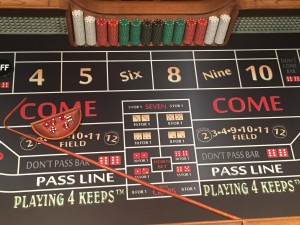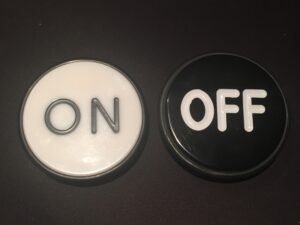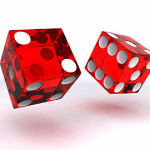Lesson One
The Basics of the Game
~Click on images to enlarge~
My purpose with these lessons is to provide the reader with simple explanations of how the game is played. The lessons will represent craps instruction for basic play. Once you have thoroughly studied the lessons, you should be able to go to a casino and comfortably play a game of dice. The lessons take you through the game, start to finish, play by play and bet by bet. One of my goals is to instill confidence by eliminating trepidation and intimidation. Knowledge is power. The most important goal for you is to be empowered with a knowledgeable approach to the game.
When you stand at a craps table for the first time, you may feel overwhelmed by the excitement and seemingly quick pace of the game. You may experience confusion as other players call out bets and toss around chips to the dealers, who are expertly booking the bets. With all of this going on, the stickman is calling out orders like a carnival barker, demanding players to “place their bets!” Adding to your confusion could be the unfamiliar vocabulary. There is one thing you may understand; everyone but you seems to know what the hell is going on.
To the novice player, all of this commotion and excitement makes the game seem complicated if not downright scary! There is a solution for you. All you have to do is spend a little time reading through the lessons for How to Play Dice. Are you ready to get going? Good, let’s get started with the Lesson One.
Kind of vulgar, isn’t it?
First, what is a craps game? It is a series of events, involving two dice, with players making bets and having specific rules of play. Craps is also a zero sum game, “somebody is going to lose.”
Next, I’ll answer the question about the name. There are a few different explanations for how the game became known as craps. Here’s my short version. The roll 1/1 was called crabs as in crab’s eyes. “Crab’s eyes” changed to just crabs, over time. As the game expanded into other cultures, players who were hard of hearing or lacked a command of the English language, pronounced the 1/1 roll, craps. The rest is history, but this is a dice lesson, not a history lesson.
The dice lessons you are about to learn are a totally different and unique in approach to understanding how to play craps. There are around forty ways of losing your money in a craps game. Let’s call them bets. I will address the basics of preferred bets and bash the bets to avoid, by the end of these lessons. After all, you do want to be a winner, right?
Craps versus Dice
Dice or Craps, what’s the difference? There are really two parts to the game. Part one is called craps and part two is called dice. Each part will be explained so you will know the difference.
In the beginning, in the first part of the game, you are playing craps. You are playing “craps” only during a Come Out roll. “The dice are coming out”, is announced by the dealer, and tells the players that the “game” is about to begin. A Come Out roll designates the beginning of a new game.
On a Come Out roll the following numbers are “live”: 2, 3, 12, 7 and 11. Collectively, these numbers are known as “Naturals”. When any of these numbers roll on a Come Out you can win or lose money, depending upon your bet. The various plays and bets made during a Come Out roll will be covered individually in the lessons that follow.
When any of the other possible numbers roll during a Come Out, (4-5-6-8-9-10), the game shifts from craps mode to dice mode. Rolling (4-5-6-8-9-10) sets a point. The dice game is on with an established point number. The dealer will then mark the point by placing the puck on the box number with the ON side of the puck up. Once establishing a point that is (4-5-6-8-9-10) the follow numbers are no longer live, 2, 3, 11, and 12. Only the 7 is still live and can influence the outcome of the game.
In craps mode, a seven on the Come Out is a winning roll for a Pass Line bet. However, in dice mode, the seven’s influence is a huge negative for most of the bets. In dice mode, a seven roll causes a dice game to end. The seven has the most possible combinations on a pair of dice. (six) This is how the casino maintains an advantage over the players’ bets. Since there are more ways to roll a 7 than for any of the box numbers, (4-5-6-8-9-10) theoretical probability predicts that a 7 will roll before the point. Thus, once in dice mode, the casino has a distinct advantage over bets made on (4-5-6-8-9-10). There are a few other bets that will also lose, but I’m keeping it to the basics here. More on other bets and high risk bets in later lessons.
It may seem silly to differentiate between craps and dice. In general the two terms are frequently used synonymous. I feel the need for the explanation, as the terms actually define different times during the game, and thus, slightly different rules. Now you know the meaning of craps and dice terms and when they actually apply in a game.
Okay, time out, let’s do a quick review.
There are two phases to the game, craps mode and dice mode. Together the two phases blend together to make up a craps game. A craps game begins with a Come Out roll, 2, 3, 12, 7, and 11 are Naturals, live numbers. Winning or losing can occur when any of these numbers roll on a Come Out. A point is established during a Come Out when (4-5-6-8-9-10) is rolled. Once a point of (4-5-6-8-9-10) is established, the 2, 3, 11, and 12 are neutral (unless you make a one roll bet on these numbers) and only a 7 still has influence in the game’s outcome. In dice mode, the 7 ends the game.
Next, in Lesson Two, you will meet the crew and follow the game in action.
Get ready, the dice are coming out!
Return to the Table of Contents
Copyright © 2006-2015 Michael Vernon – Playing 4 Keeps®





